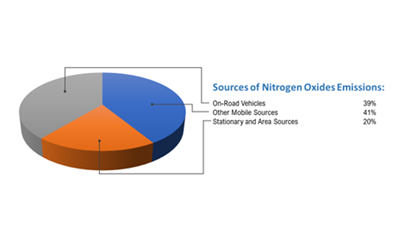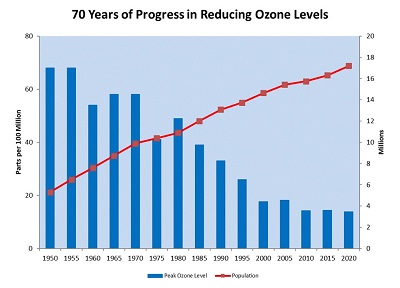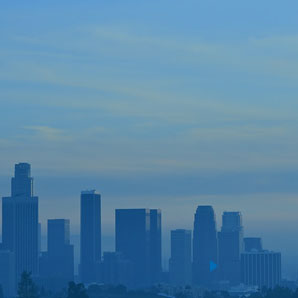About South Coast AQMD (original) (raw)
Mission
To clean the air and protect the health of all residents in the South Coast Air District through practical and innovative strategies.
Who is South Coast AQMD?
South Coast AQMD is the regulatory agency responsible for improving air quality for large areas of Los Angeles, Orange, Riverside and San Bernardino counties, including the Coachella Valley. The region is home to more than 17 million people–44% of the population of the entire state of California.
Despite significant improvements to air quality, more work needs to be done to protect public health through innovative and practical strategies. Air pollution can cause or worsen many health problems, including asthma attacks, respiratory disease, heart disease, certain types of cancers and premature death. South Coast AQMD has been at the forefront of the nation’s air pollution reduction efforts since 1947. That year, the Los Angeles County Board of Supervisors established the nation's first air pollution control program by creating the Los Angeles County Air Pollution Control District, our predecessor agency.
What South Coast AQMD Does

South Coast AQMD is responsible for controlling emissions primarily from stationary sources of air pollution. These can include anything from large power plants and refineries to the corner gas station. There are about 25,500 such businesses operating under South Coast AQMD permits. Many consumer products also cause air emissions; these include house paint, furniture varnish, and thousands of products containing solvents that evaporate into the air. About 20% of this area's ozone-forming air pollution comes from stationary sources, both businesses and residences. The other 80% comes from mobile sources–mainly cars, trucks, and buses, but also construction equipment, ships, trains, and airplanes. Emission standards for mobile sources are established by state or federal agencies, such as the California Air Resources Board and the U.S. Environmental Protection Agency, rather than by local agencies such as the South Coast AQMD.
How South Coast AQMD Controls Pollution

Periodically, South Coast AQMD develops and adopts an Air Quality Management Plan, which serves as the blueprint to bring this area into compliance with federal and state clean air standards. Rules are adopted to reduce emissions from various sources, including specific types of equipment, industrial processes, paints, and solvents, even consumer products. Permits are issued to many businesses and industries to ensure compliance with air quality rules.
South Coast AQMD conducts regular inspections of businesses and other sources of air pollution to evaluate compliance with applicable air quality rules and permit conditions. Inspectors also respond to air quality complaints received from the public. When noncompliance is observed, inspectors take enforcement action by issuing compliance notices to obtain information or to document violations of air quality rules, which can result in civil penalties.
South Coast AQMD operates a network of air quality monitors continuously at nearly 40 permanent locations throughout the four-county area, and an additional 10 community sites near the large refineries. This also allows South Coast AQMD to notify the public whenever air quality is unhealthful.
Progress So Far
Air quality continually improves despite an enormous increase in population and cars. For example, maximum levels of ozone, one of our worst smog problems, have been cut to less than one quarter of what they were in the 1950s, even though today we have nearly three times as many people and four times as many vehicles.
In recent decades, Stage I smog alerts have been eliminated, which used to occur 100-120 times a year. Stage II smog levels have not occurred since the 1980s.
South Coast AQMD’s Sources of Revenue
To meet its financial need, the South Coast AQMD utilizes a system of evaluation fees, annual operating fees, emission fees, Hearing Board fees, penalties/ settlements and investments that generate approximately 73% of South Coast AQMD’s revenue. The remaining 27% of its revenue is from federal grants, California Air Resources (CARB) subvention funds, and California Clean Air Act Motor Vehicle fees.
The Job Ahead
The clean air effort still has a long way to go. In 2015, the federal 8-hour ozone standard was replaced by a stricter standard, reducing the standard from 75 ppb to 70 ppb. While air quality has improved over the past several decades, South Coast Air Basin has exceeded the federal health 8-hour ozone standard 124 days in 2022, based on preliminary data. Maximum levels are almost twice as high as the federal standard for clean air.
State and federal law requires this area to meet existing clean air standards by the year 2025 for annual PM 2.5; and by 2037 for the 8-hour average ozone standard. Meeting the standards will require collaboration across state and local agencies as well as the federal government. Federal sources of emissions, which include ships, locomotives, heavy-duty trucks and planes, will make up more than one-third of pollution in the region in 2037.
With continued commitment and sensitivity to the impacts of efforts to control smog, residents can be assured that public health standards for air quality will be achieved.
How You Can Help
A lot of our pollution comes from the products and services we use every day. We can all help by making some simple changes in the way we live: carpool, use public transit, use water-based paint, wet down sources of dust, avoid burning wood, replace your gasoline-powered lawn and garden equipment with electric models, and conserve energy.
For additional information, call 1-800-CUT SMOG® to order South Coast AQMD’s free publications; or you can view and download them from our Documents, Reports & Publications page.

Locations
See South Coast AQMD locations and contact info

Careers
Learn about South Coast AQMD career opportunities